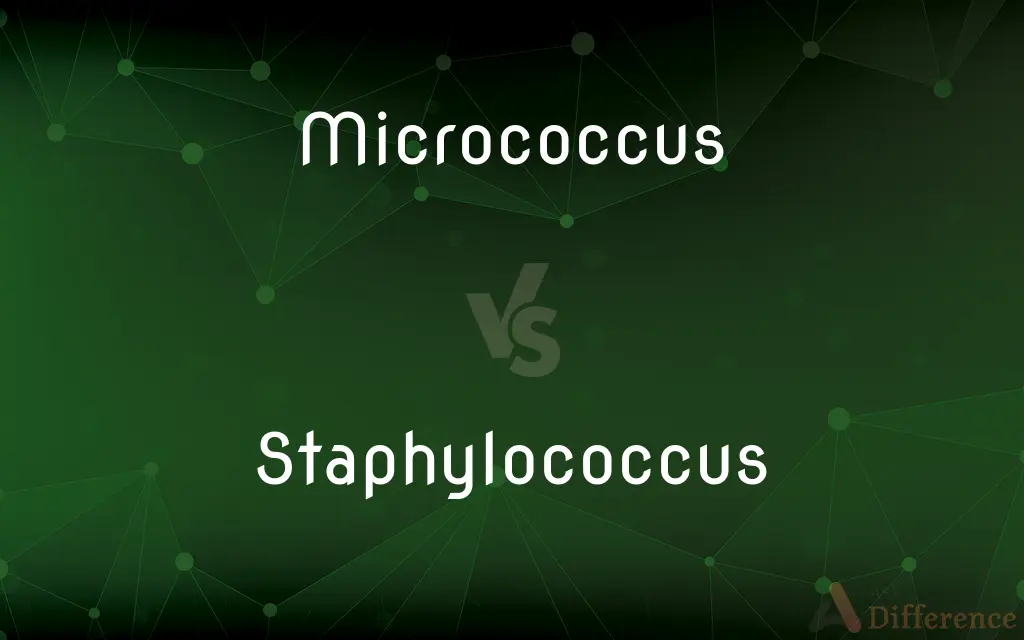Micrococcus vs. Staphylococcus — What's the Difference?
Edited by Tayyaba Rehman — By Maham Liaqat — Updated on March 16, 2024
Micrococcus are generally harmless, spherical bacteria found in soil and water, often involved in the degradation of pollutants, whereas Staphylococcus includes species that can be pathogenic to humans, commonly found on the skin and mucous membranes.

Difference Between Micrococcus and Staphylococcus
Table of Contents
ADVERTISEMENT
Key Differences
Micrococcus species are characterized by their presence in diverse environments such as soil, water, and dust, playing a role in the ecosystem by breaking down organic materials and pollutants. These bacteria are typically non-pathogenic and are known for their bright colors, which can range from yellow to red. On the other hand, Staphylococcus species are often found on the skin and mucous membranes of humans and animals, and while some species are harmless, others, like Staphylococcus aureus, can cause serious infections including skin infections, pneumonia, and sepsis.
Micrococcus bacteria are cocci (spherical) and tend to form tetrads or irregular clusters, adapting well to high salt, radiation, and desiccation conditions, which makes them resilient in various environments. In contrast, Staphylococcus bacteria also have a spherical shape but are known for their tendency to form grape-like clusters. They are facultative anaerobes, meaning they can grow without oxygen, and some species have developed resistance to antibiotics, posing significant challenges in healthcare settings.
In terms of scientific and medical interest, Micrococcus is less frequently associated with human disease, making it less of a focus for clinical research compared to Staphylococcus, which includes strains resistant to methicillin (MRSA) and is a significant concern in hospitals and healthcare environments due to its role in nosocomial infections.
Both genera belong to the family Micrococcaceae and share some morphological traits, but their ecological roles, pathogenic potential, and significance to humans differ markedly. Micrococcus's role in environmental processes and Staphylococcus's importance in public health highlight the diversity and complexity within bacterial genera.
The study of Micrococcus has contributed to understanding bacterial resistance to extreme conditions, while research on Staphylococcus has been crucial in developing treatments for bacterial infections, underscoring the importance of both genera in microbiology and medicine.
ADVERTISEMENT
Comparison Chart
Habitat
Soil, water, dust
Human and animal skin, mucous membranes
Pathogenicity
Generally non-pathogenic
Ranges from non-pathogenic to highly pathogenic
Shape and Arrangement
Cocci, forming tetrads or irregular clusters
Cocci, forming grape-like clusters
Ecological Role
Decomposition, pollutant degradation
Part of normal flora, can cause infections
Significance to Humans
Environmental significance
Significant in healthcare due to pathogenic strains
Compare with Definitions
Micrococcus
They are known for their bright pigments and spherical shape.
The yellow color of some Micrococcus colonies is due to carotenoid pigments.
Staphylococcus
Staphylococcus species can range from harmless to highly pathogenic.
Staphylococcus epidermidis is part of the skin's normal flora.
Micrococcus
Micrococcus species are resilient, tolerating harsh conditions.
Micrococcus survives in extreme environments like high radiation areas.
Staphylococcus
Staphylococcus forms grape-like clusters and is found on skin.
Staphylococcus colonies are often identified by their clustering pattern.
Micrococcus
Micrococcus are environmental bacteria involved in degrading pollutants.
Micrococcus luteus breaks down hydrocarbons in oil spills.
Staphylococcus
They are known for causing skin infections and more severe diseases.
Staphylococcus aureus can cause cellulitis and MRSA infections.
Micrococcus
Rarely pathogenic to humans, Micrococcus is generally harmless.
Micrococcus infections in humans are extremely uncommon.
Staphylococcus
Some Staphylococcus strains are resistant to antibiotics.
MRSA is a concern in hospitals due to its methicillin resistance.
Micrococcus
They are typically found in soil, water, and on inanimate objects.
Micrococcus can be isolated from household dust.
Staphylococcus
Staphylococcus plays a role in both health and disease.
While some species are benign, others necessitate rigorous medical treatment.
Micrococcus
Micrococcus (mi’ krō kŏk’ Əs) is a genus of bacteria in the Micrococcaceae family. Micrococcus occurs in a wide range of environments, including water, dust, and soil.
Staphylococcus
Staphylococcus is a genus of Gram-positive bacteria in the family Staphylococcaceae from the order Bacillales. Under the microscope, they appear spherical (cocci), and form in grape-like clusters.
Micrococcus
Any of various spherical, aerobic, gram-positive bacteria of the genus Micrococcus that are usually nonmotile and occur in pairs, tetrads, or irregular clusters.
Staphylococcus
Any of various spherical gram-positive parasitic bacteria of the genus Staphylococcus that usually occur in grapelike clusters and commonly cause skin infections such as cellulitis and impetigo and other infectious conditions and diseases.
Micrococcus
(biology) Any of a group of spherical, aerobic, gram-positive bacteria, of the genus Micrococcus, that are wide-ranging and harmless.
Staphylococcus
A spherical gram-positive parasitic bacterium of the genus Staphylococcus, causing blisters, septicemia, and other infections.
Micrococcus
A genus of Spherobacteria, in the form of very small globular or oval cells, forming, by transverse division, filaments, or chains of cells, or in some cases single organisms shaped like dumb-bells (Diplococcus), all without the power of motion. See Illust. of Ascoccus.
Staphylococcus
Spherical gram-positive parasitic bacteria that tend to form irregular colonies; some cause boils or septicemia or infections
Micrococcus
Type genus of the family Micrococcaceae
Common Curiosities
Are Micrococcus bacteria harmful to humans?
Micrococcus species are generally not harmful to humans and are rarely associated with diseases.
Is there a relationship between Micrococcus and antibiotic production?
While Micrococcus is not a major source of antibiotics, its resistance mechanisms to certain environmental stresses can provide insights into antibiotic resistance.
What is Micrococcus?
Micrococcus is a genus of bacteria known for its environmental presence and role in degrading organic substances and pollutants.
What is Staphylococcus?
Staphylococcus is a genus of bacteria that includes species ranging from harmless to those that cause significant human infections.
How are Micrococcus and Staphylococcus bacteria identified?
They can be identified through their morphological characteristics, such as shape and clustering, as well as through biochemical tests and genetic analysis.
Why is Staphylococcus a concern in healthcare?
Certain Staphylococcus species, particularly Staphylococcus aureus, can cause serious infections, and some strains have developed resistance to multiple antibiotics, making them a significant healthcare challenge.
Can Micrococcus be used in bioremediation?
Yes, some Micrococcus species are utilized in bioremediation processes to break down environmental pollutants.
What are common diseases caused by Staphylococcus?
Staphylococcus can cause a range of diseases, from skin infections like boils and cellulitis to more severe conditions such as pneumonia, septicemia, and toxic shock syndrome.
How do Micrococcus and Staphylococcus differ in their habitats?
Micrococcus is primarily found in environmental settings like soil and water, whereas Staphylococcus is commonly located on the skin and mucous membranes.
What measures can be taken to prevent Staphylococcus infections?
Preventative measures include good hygiene practices, proper wound care, and careful management of medical devices and hospital environments to reduce the risk of infections, especially with antibiotic-resistant strains.
Share Your Discovery

Previous Comparison
Traffic vs. Transportation
Next Comparison
Print vs. ScriptAuthor Spotlight
Written by
Maham LiaqatEdited by
Tayyaba RehmanTayyaba Rehman is a distinguished writer, currently serving as a primary contributor to askdifference.com. As a researcher in semantics and etymology, Tayyaba's passion for the complexity of languages and their distinctions has found a perfect home on the platform. Tayyaba delves into the intricacies of language, distinguishing between commonly confused words and phrases, thereby providing clarity for readers worldwide.
















































